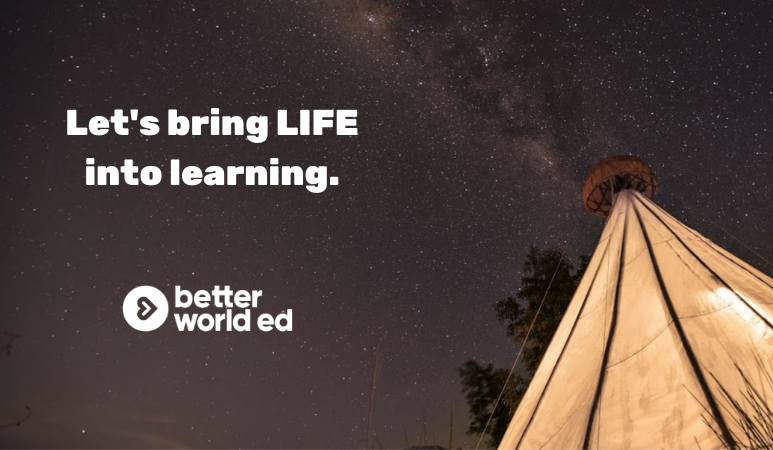We all know Social Emotional Learning (SEL) is deeply important for all students (and all of us teachers, too). We know it’s not enough to just sprinkle SEL in here and there. We’ve got to integrate SEL with academics in an inclusive, meaningful, and ongoing way, which is clearly shown in research.
But how? After all, none of us want SEL to become just another box to check off the list.
Enter Wordless Videos. Videos about real people around the world that take us on a journey through their life and story. Without any narration.
Why wordless? Check out an example:
I Am Norma // Bananas & Gratitude from Better World Ed on Vimeo.
A wordless video creates an opportunity to engage every student. Students can understand the video without narration or subtitles. With 1 in 10 youth in the U.S. being an ELL (English Language Learner), it’s critical that we make content diverse and inclusive in every possible way.
Plus, when words are in a video, viewers focus on reading subtitles or hearing narration. This can prevent mindful observation and deep immersion in the story. Moving beyond words can create an opportunity for students to observe, question, and introspect. These are critical practices that develop social and emotional competencies.
Through BetterWorldEd.org “Learning Journey” stories, we’ve observed students (and teachers) demonstrating deeper curiosity about themselves, others, and our world. We’ve heard students share powerful perspectives after watching wordless stories, including the following:
- “This is the first time in my life I feel like I’m not being told what to think.”
- “Everyone’s always telling me what to believe and how things work. I feel like now I get to think for myself.”
- “I’m always wondering about stuff. This is so cool because I get to do it while learning about the world.”
When we sit down at a meeting or walk into classroom, there is no voiceover telling us who other people are, what they’re thinking, or what they’re feeling. We have to wonder. We have to engage. Yet too often we settle with our judgments — about self, other people, cultures, and ways of life — instead of remaining curious beyond that initial judgment. And starting at just 3, this judgment and prejudice begin, before most kids can even read. Wordless videos help kids develop values to act on their curiosity about others, different perspectives, and unique lifestyles. This practice is also showing merit for academic learning.
Wordless stories have been shown to boost curiosity and engagement, improve reading comprehension and academic learning, and help students explore topics of interest. The benefits are interconnected: fostering curiosity and a sense of purpose is fundamental for a student’s academic success, and early math and reading success is a strong predictor of long-term success. New research is also showing that curiosity building can play a huge role in a student’s long-term learning.
Stories move people to action, and understanding how to engage content is critical in the digital age.
Here are three ways you can use Wordless Videos to ignite curiosity, empathy, critical thinking, and compassion, bringing SEL to life in your classroom:
- Morning Meeting: Set the climate of the day by practicing social-emotional skills. Ask students how they are feeling today, and then encourage them to reflect on a BIG question from a paired lesson plan, like “What does it mean to be ‘confident’? How do we develop confidence in a healthy way?” From there, you can have students watch the wordless video and then circle back to the big question to discuss as a class. Then, wrap up morning meeting by making a personal connection to your students. Ask a question like “What are you going to do to help others be confident today?” To save time, you can have students talk in pairs or small groups and then highlight two or three responses that you heard!
- Math Unit Opener: Kick off a unit that students are not jazzed about with a real-world video that makes math relevant. Common Core aligned math problems are included in every story and lesson, making it easy to use within your math block or to kick off your unit.
- Global Literacy Discussion Prompt:Talk about a literacy concept like author’s purpose in a meaningful way through using a wordless video from any part of the world. The written narratives paired with each Wordless Video have themes addressing topics such as clean water, renewable energy, and health, you can focus on the UN Sustainable Development Goals (SDGs) while also accomplishing your literacy goals, “Global Literacy”. All through using a wordless video as a hook.
There are hundreds of ways to use Wordless Videos as a powerful classroom practice. We hope these ideas help you get started in a captivating, emotive, and global way.
Let’s bring SEL to life together. Beyond words.
Explore dozens of Wordless Videos at BetterWorldEd.org. Explore more about how to use Wordless Videos in our Educator Blog. Learn more about our Learning Journey in this recent storytelling podcast.






